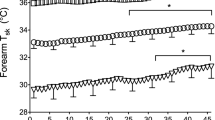Abstract
The aim of the present study was to examine changes in the control of heat-dissipation responses to exercise associated with the diurnal variation in core temperature from the viewpoint of the regional response patterns. We studied seven men during exercise on a cycle ergometer at 100 W for 40 min at 25°C at 0630 (morning) 1630 (evening) hours on 2 separate days. Oesophageal temperature (T oes), local skin temperature, local sweating rate (\(\dot m_{sw} \)) on the forehead, back, forearm and thigh, and skin blood flow by laser Doppler flowmeter (LDF) on the back and forearm were measured continuously. TheT oes at rest was significantly higher in the evening than in the morning, the difference averaging approximately 0.4°C (P < 0.05). TheT oes thresholds for each site in\(\dot m_{sw} \) and that for back in LDF were significantly different between the two times of day (P < 0.05). The change inT oes thresholds for sweating and vasodilatation for morning and evening were similar toT oes at rest. Although\(\dot m_{sw} \) on the forehead was significantly higher in the morning than in the evening,\(\dot m_{sw} \) on the back was significantly higher in the evening than in the morning (P < 0.05). Total local sweating rate (\(\dot m_{sw} ,_{tot} \)) for each site during exercise was significantly higher on the forehead than on the forearm in the morning, and on the back than on the forearm in the evening, respectively (P < 0.05). The results would suggest that the diurnal variation of heat-dissipation responses to exercise is influenced not only by a central controlling mechanism but also by changes in the regional differences.
Similar content being viewed by others
References
Aschoff J, Heise A (1972) Thermal conductance in man: its dependence on time of day and on ambient temperature. In: Itoh S et al(eds) Advances in climatic physiology. Igaku Shoin, Tokyo, pp 334–348
Aschoff J, Biebach H, Heise A, Schmidt T (1974) Day-night variation in heat balance. In: Monteith JL, Mount LE (eds) Heat loss from animals and man. Butterworth, London, pp 147–172
Drinkwater BL, Bedi JF, Loucks AB, Roche S, Horvath SM (1982) Sweating sensitivity and capacity of women in relation to age. J Appl Physiol 53:671–676
Fox RH, Hilton SM (1958) Bradykinin formation in human skin as a factor in heat vasodilatation. J Physiol (Lond) 142:219–232
Höfler W (1968) Changes in regional distribution of sweatiing during acclimatization to heat. J Appl Physiol 25:503–506
Kuno Y (1956) Human perspiration. Thomas, Springfield, III.
Nadel ER, Mitchell JW, Saltin B, Stolwijk AJ (1971a) Peripheral modifications to the central drive for sweating. J Appl Physiol 31:828–833
Nadel ER, Bullard RW, Stolwijk AJ (1971b) Importance of skin temperature in the regulation of sweating. J Appl Physiol 31:80–87
Nishiyasu T, Shi X, Gillen CM, Mack GW, Nadel ER (1992) Comparison of forearm and calf blood flow response to thermal stress during dynamic exercise. Med Sci Sports Exerc 24:213–217
Ramanathan NL (1964) A new weighting system for mean surface temperature of the human body. J Appl Physiol 19:531–533
Rothman S (1954) Physiology and biochemistry of the skin. University of Chicago Press, Chicago, pp 158–161
Saumet JJ, Kellogg DL Jr, Taylor WF, Johnson JM (1988) Cutaneous laser-Doppler flowmetry: influence of underlying muscle blood flow. J Appl Physiol 65:478–481
Smolander J, Harma M, Lindqvist A, Kolari P, Laitinen LA (1993) Circadian variation in peripheral blood flow in relation to core temperature at rest. Eur J Appl Physiol 67:192–196
Stephenson LA, Wenger CB, O'Donovan BH, Nadel ER (1984) Circadian rhythm in sweating and cutaneous blood flow. Am J Physiol 246:R321-R324
Tanaka H, Yanase M, Kanosue K, Nakayama T (1990) Circadian variation of thermoregulatory responses during exercise in rat. Am J Physiol 258:R836-R841
Winget CM, Deroshia CW, Holley DC (1985) Circadian rhythms and athletic performance. Med Sci Sports Exerc 17:498–516
Author information
Authors and Affiliations
Rights and permissions
About this article
Cite this article
Aoki, K., Shiojiri, T., Shibasaki, M. et al. The effect of diurnal variation on the regional differences in sweating and skin blood flow during exercise. Europ. J. Appl. Physiol. 71, 276–280 (1995). https://doi.org/10.1007/BF00854991
Accepted:
Issue Date:
DOI: https://doi.org/10.1007/BF00854991




